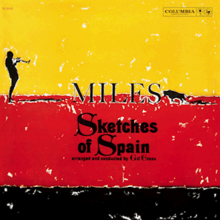Sketches of Spain
| Sketches of Spain | ||||
|---|---|---|---|---|
 |
||||
| Studio album by Miles Davis | ||||
| Released | July 18, 1960 | |||
| Recorded | November 20, 1959; March 10, 1960 | |||
| Studio |
Columbia 30th Street Studio New York City |
|||
| Genre | Third stream,orchestral jazz | |||
| Length | 41:19 | |||
| Label | Columbia | |||
| Producer | Teo Macero, Irving Townsend | |||
| Miles Davis chronology | ||||
|
||||
| Professional ratings | |
|---|---|
| Review scores | |
| Source | Rating |
| AllMusic | |
| Down Beat | |
| Encyclopedia of Popular Music | |
| MusicHound Jazz | 4.5/5 |
| The Penguin Guide to Jazz | |
| Pitchfork Media | 10/10 |
| PopMatters | 10/10 |
| Q | |
| The Rolling Stone Album Guide | |
| Sputnikmusic | 4/5 |
Sketches of Spain is an album by Miles Davis, recorded between November 1959 and March 1960 at the Columbia 30th Street Studio in New York City. An extended version of the second movement of Joaquín Rodrigo's Concierto de Aranjuez (1939) is included, as well as a song called "Will o' the Wisp", from Manuel de Falla's ballet El amor brujo (1914–1915). Sketches of Spain is regarded as an exemplary recording of Third Stream, a musical fusion of jazz, European classical, and styles from world music.
The album pairs Davis with arranger and composer Gil Evans, with whom he had collaborated on several other projects, on a program of compositions largely derived from the Spanish folk tradition. Evans explained:
[We] hadn't intended to make a Spanish album. We were just going to do the Concierto de Aranjuez. A friend of Miles gave him the only album in existence with that piece. He brought it back to New York and I copied the music off the record because there was no score. By the time we did that, we began to listen to other folk music, music played in clubs in Spain... So we learned a lot from that and it ended up being a Spanish album. The Rodrigo, the melody is so beautiful. It's such a strong song. I was so thrilled with that.
The opening piece, taking up almost half the record, is an arrangement by Evans and Davis of the adagio movement of Concierto de Aranjuez, a concerto for guitar by the contemporary Spanish composer Joaquín Rodrigo. Following the faithful introduction of the concerto's guitar melody on flugelhorn, Evans' arrangement turns into a "quasi-symphonic, quasi-jazz world of sound", according to his biographer. The middle of the piece contains a "chorus" by Evans unrelated to the concerto but "echoed" in the other pieces on the album. The original melody then reappears in a darker mode.
...
Wikipedia
